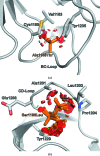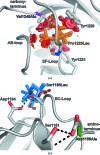Structure of filamin A immunoglobulin-like repeat 10 from Homo sapiens
- PMID: 21821884
- PMCID: PMC3151117
- DOI: 10.1107/S1744309111024249
Structure of filamin A immunoglobulin-like repeat 10 from Homo sapiens
Abstract
Filamin A (FlnA) plays a critical role in cytoskeletal organization, cell motility and cellular signaling. FlnA utilizes different binding sites on a series of 24 immunoglobulin-like domains (Ig repeats) to interact with diverse cytosolic proteins and with cytoplasmic portions of membrane proteins. Mutations in a specific domain, Ig10 (FlnA-Ig10), are correlated with two severe forms of the otopalatodigital syndrome spectrum disorders Melnick-Needles syndrome and frontometaphyseal dysplasia. The crystal structure of FlnA-Ig10 determined at 2.44 Å resolution provides insight into the perturbations caused by these mutations.
Figures




Similar articles
-
Biochemical basis of the interaction between cystic fibrosis transmembrane conductance regulator and immunoglobulin-like repeats of filamin.J Biol Chem. 2010 May 28;285(22):17166-76. doi: 10.1074/jbc.M109.080911. Epub 2010 Mar 29. J Biol Chem. 2010. PMID: 20351101 Free PMC article.
-
Cystic fibrosis transmembrane conductance regulator interacts with multiple immunoglobulin domains of filamin A.J Biol Chem. 2010 May 28;285(22):17156-65. doi: 10.1074/jbc.M109.080523. Epub 2010 Mar 29. J Biol Chem. 2010. PMID: 20351098 Free PMC article.
-
The evolution of filamin-a protein domain repeat perspective.J Struct Biol. 2012 Sep;179(3):289-98. doi: 10.1016/j.jsb.2012.02.010. Epub 2012 Mar 10. J Struct Biol. 2012. PMID: 22414427 Free PMC article.
-
New insights into the versatile roles of platelet FlnA.Platelets. 2013;24(1):1-5. doi: 10.3109/09537104.2011.654004. Epub 2012 Feb 28. Platelets. 2013. PMID: 22372530 Free PMC article. Review.
-
Structural and functional aspects of filamins.Biochim Biophys Acta. 2001 Apr 23;1538(2-3):99-117. doi: 10.1016/s0167-4889(01)00072-6. Biochim Biophys Acta. 2001. PMID: 11336782 Review.
Cited by
-
Electron microscopy and 3D reconstruction reveals filamin Ig domain binding to F-actin.J Mol Biol. 2012 Dec 14;424(5):248-56. doi: 10.1016/j.jmb.2012.09.025. Epub 2012 Oct 4. J Mol Biol. 2012. PMID: 23041423 Free PMC article.
-
Filamin A interaction with the CXCR4 third intracellular loop regulates endocytosis and signaling of WT and WHIM-like receptors.Blood. 2015 Feb 12;125(7):1116-25. doi: 10.1182/blood-2014-09-601807. Epub 2014 Oct 29. Blood. 2015. PMID: 25355818 Free PMC article.
-
Prune belly syndrome in surviving males can be caused by Hemizygous missense mutations in the X-linked Filamin A gene.BMC Med Genet. 2020 Feb 21;21(1):38. doi: 10.1186/s12881-020-0973-x. BMC Med Genet. 2020. PMID: 32085749 Free PMC article.
-
The FLNC Ala1186Val Variant Linked to Cytoplasmic Body Myopathy and Cardiomyopathy Causes Protein Instability.Biomedicines. 2024 Jan 30;12(2):322. doi: 10.3390/biomedicines12020322. Biomedicines. 2024. PMID: 38397924 Free PMC article.
-
UVB mutagenesis differs in Nras- and Braf-mutant mouse models of melanoma.Life Sci Alliance. 2021 Jul 1;4(9):e202101135. doi: 10.26508/lsa.202101135. Print 2021 Sep. Life Sci Alliance. 2021. PMID: 34210801 Free PMC article.
References
-
- Adams, P. D. et al. (2010). Acta Cryst. D66, 213–221.
-
- Bork, P., Holm, L. & Sander, C. (1994). J. Mol. Biol. 242, 309–320. - PubMed
-
- DeLano, W. L. (2002). PyMOL http://www.pymol.org.
Publication types
MeSH terms
Substances
Associated data
- Actions
Grants and funding
LinkOut - more resources
Full Text Sources
Miscellaneous

